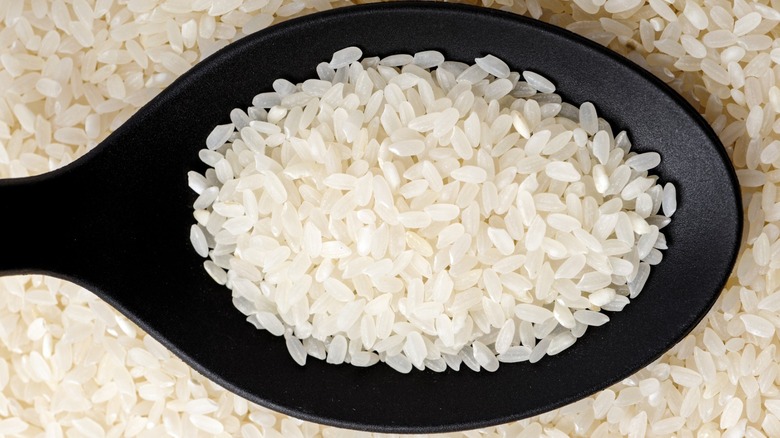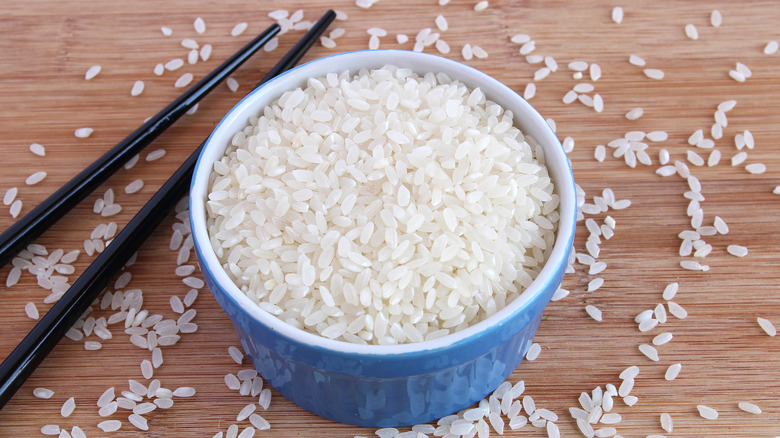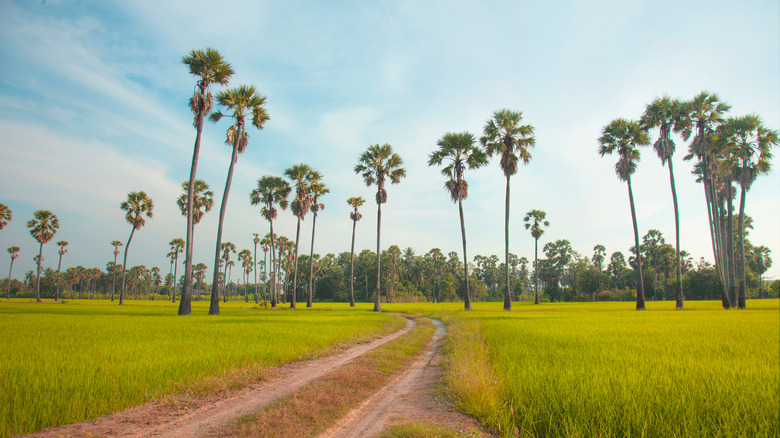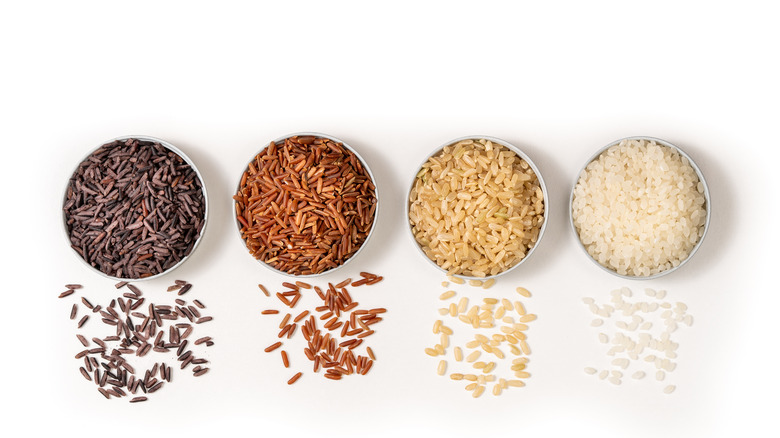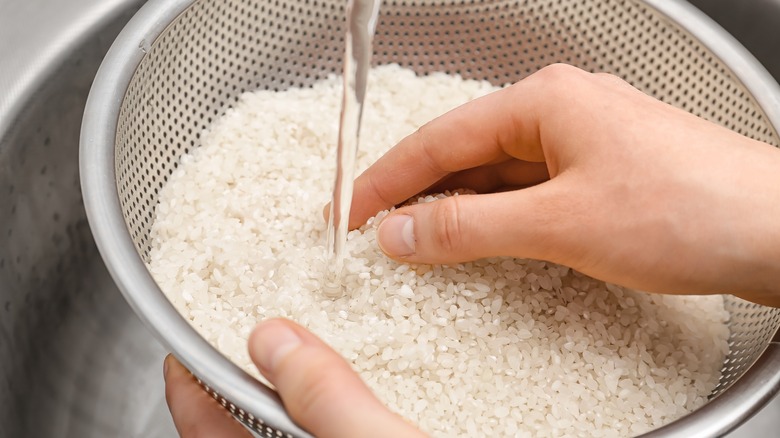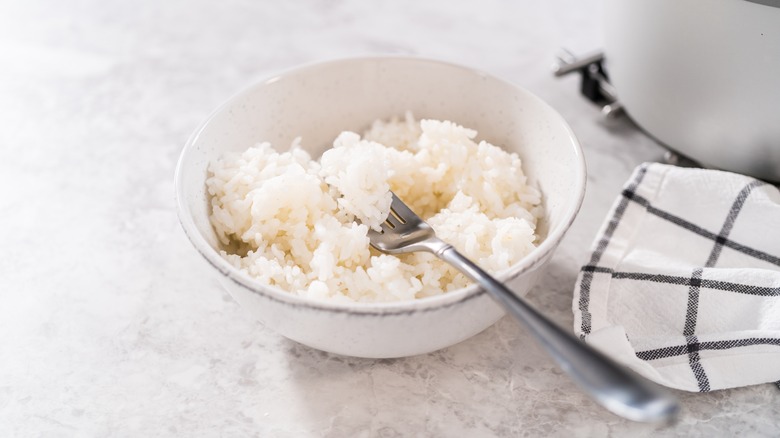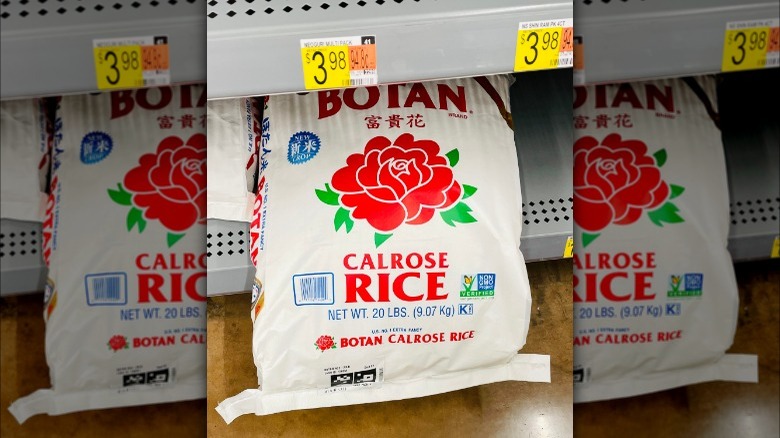What Is Calrose Rice And How Do You Best Cook It?
You may not have tried Calrose rice yourself, but you've sure enough seen it at a store or hiding in a pantry. While it may not be as well known as its basmati and jasmine counterparts, which have been around for thousands of years, Calrose has acquired quite the reputation in the mere 70 years since it kickstarted California's rice game — and it has the cult following to back it up.
Often referred to as "all-purpose" rice, Calrose is the perfect medium between the short and long-grain rice varieties you may be used to, and, being medium-grain, it performs equally as well as a substitute for each — but that's not only due to its grain size. Calrose rice is soft, slightly sticky, mild, and not nearly as finicky to prepare as other rice varieties, making it a great alternative for your at-home sushi rolls or served alongside your favorite protein and veggies.
What is Calrose rice?
Calrose rice is a variety of medium-grain white rice that was developed at the Rice Experiment Station by the California Cooperative Rice Research Foundation. In fact, Calrose is often thought of as the "founding" grain for the Californian rice industry, hence the "Cal" in its name (the "rose" part is just a continuation of a rice naming tradition). Released to California farmers in 1948, Calrose rice makes up a total of 85% of all Californian rice production to this day.
Calrose rice is the "it" rice that can be found in the pantries of foodie influencers, chefs, and home cooks alike — and once you try it, you may not be able to stop storing it in your pantry either. That's because, being medium-grain rice, Calrose rice has a texture that's sticky enough to be substituted for your mango sticky rice and fluffy enough to perform in the place of your jasmine. Its versatility, paired with its mild flavor and simple preparation, is what makes it such a staple in your kitchen.
Calrose rice history
The origins of rice can be traced back to over 7,000 years ago when, depending on which experts you ask, it was either first cultivated in China or India. But the history of Calrose rice is much more recent, beginning in the early 20th century with the first wave of Californian rice farmers. While other U.S. states like Virginia had been producing rice since the 17th century, the prospect of striking gold resulted in an influx of Chinese immigration to the country's West Coast, otherwise known as the Gold Rush. By the mid-1850s, a few different things were happening: The Chinese immigrant population was growing, as was the total Californian population, and some of them were striking it rich, as others were not.
At the same time, while the Department of Agriculture was looking for a way to meet California's rising food demand, the influx of Chinese diets in the state lit a lightbulb in their minds — why not grow rice right there in California rather than having it imported? Because many of the miners were farmers at home, many of them turned back to it after their luck digging for gold ran dry, eventually leading to California rice production. After years of experimentations and failures, a USDA soil specialist discovered that medium-grain rice from Japan would be better suited to California's climate and soil. Today there are 17 public varieties that are grown across the Sacramento and San Joaquin valleys, one of the most successful being Calrose.
Calrose rice vs. other types of rice
As a medium-grain rice, Calrose is very different from other, more popular varieties of rice. In comparison to jasmine rice, Calrose rice is much more sticky and mild tasting. That's because, being long-grain, jasmine rice grains tend to separate when they're prepared correctly, creating a lighter and airier consistency. As its name suggests, jasmine rice also has a much more fragrant aroma and flavor profile that many describe as slightly sweet and floral. For this reason, jasmine is much more limited in its uses compared to Calrose. The same can be said about basmati rice, another long-grain rice that has a somewhat grassy flavor.
Calrose also differs from short-grain varieties like Chinese black rice and short-grain glutinous rice in terms of size. However, it can still serve as a substitute for them. Short-grain rice typically has starchy textures that cause the grains to clump together, making them much easier to eat. These types of rice tend to be used in dishes where their texture can be used as an advantage — think rice pudding, mango sticky rice, and sushi.
How to cook Calrose rice
Preparing Calrose rice is really simple. Start by rinsing and draining a cup and a half of the rice until the water runs clear; then, following the instructions on the bag, add it and the 2 cups water for the amount of rice your preparing in a pot. From there, you can let the rice soak in the water for 15 to 30 minutes – this step is key to helping you get that signature plump texture.
After soaking your rice, turn your stovetop up to medium heat and bring the water to a boil. Once it's boiling, cut the heat down to its lowest setting, put the lid on the pot, and leave the rice for about 20 minutes. Steam off the heat for another 10 minutes, and then fluff with a fork and serve. Keep in mind that if you prefer to use a rice cooker, you should stick to the measurements indicated in the appliance manual for the best results.
What does Calrose rice taste like?
Another reason why Calrose rice has such a devoted fan base is because of its mild taste and soft, sticky texture. Never mind it being medium-grain, as the combination makes it applicable in a variety of different types of dishes and flavors. Calrose rice works wonderfully served on the side, whether it's served plain, seasoned with seaweed flakes, or cooked into fried rice, as long as it's warm and steamy.
But its sticky texture also makes it excellent in your chicken and rice soup and pickled mushroom and miso brown rice salad, as it maintains its shape and helps hold dishes together. Additionally, since it has such a light flavor and basic taste, it's the perfect foundation to absorb all of the rich flavors of your favorite curries, stews, paellas, and poke bowls.
Where to buy Calrose rice
The good thing is that, despite how popular it is, Calrose rice shouldn't be any trouble to get your hands on. In fact, you can find bags of it by the pound at most grocery stores. Brands like Botan can be found at Target and Walmart, which can be purchased in bulk bags weighing as much as 20 pounds. However, if you're new to Calrose and aren't quite ready to commit to that much at once, most brands carry more generic brands that come in smaller amounts.
Though it's not as commonly spotted in stores, an online search of Calrose rice will show that it also comes in a brown variety. While it will come with added benefits like fiber and antioxidants, it won't necessarily taste the same or cook the same way. Rather than being soft and sticky, brown Calrose rice is hearty and chewy. It also has a nutty taste to it, which may or may not complement everything. However, if you do tend to prefer brown rice over white or simply want the additional vitamins and minerals of the bran, it could be worth a try.
